GLIDERS USED IN THE
SOUTHWEST PACIFIC AREA
DURING WWII
![]()
The first glider contingent arrived by convoy in the Southwest Pacific Area in February 1943, comprising 35 pilots and 35 mechanics. An additional 52 pilots and mechanics, equally divided, joined the first detachment in April 1943.
Shortly after this, 31 crated Waco CG-4A gliders arrived in Brisbane, Queensland, Australia. The gliders that arrived at Brisbane were then assembled by the 81st Air Depot Group at Eagle Farm Airfield. It is known that 25 of the completed gliders were towed to Port Moresby in a three stage flight, and then to Dobodura. This was in preparation for the airborne operation against in the the Nadzab airfield in the Markham Valley. Three gliders were lost during the tow to Dobodura. Two gliders were lost operationally and the third glider crashed when its tail assembly broke loose in mid-air. Three men were aboard the glider. One occupant parachuted to safety while the other two occupants were unable to get out and died in the crash. Does anyone know the names of the crew?
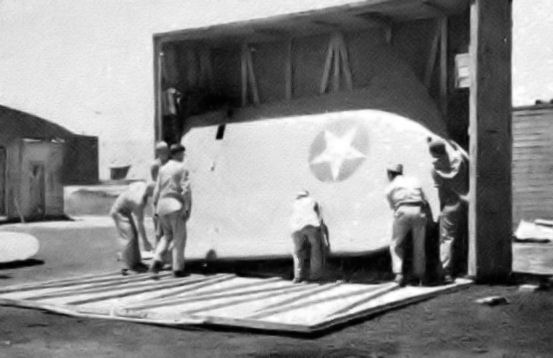
Men of 81st Air Depot Group uncrating Glider wing at Eagle Farm Airfield
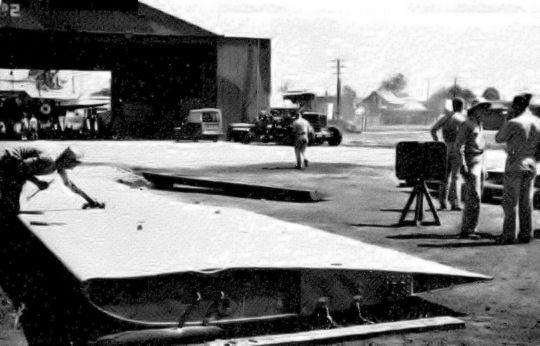
Preparing Glider wing for assembly in front of Hangar No. 2 at Eagle Farm Airfield
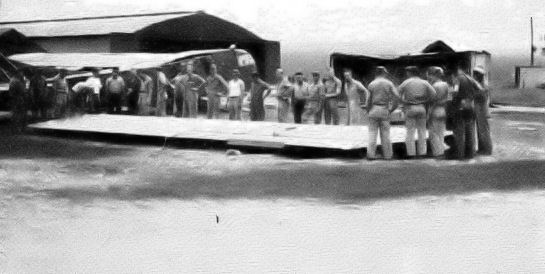
Manpower getting ready to lift the Glider wing
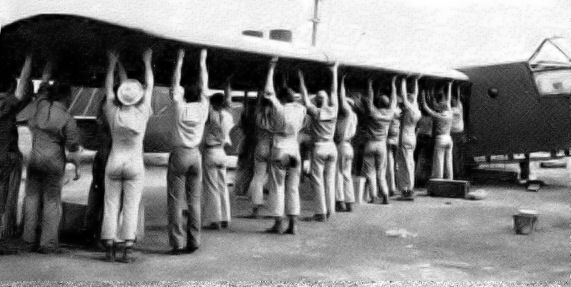
Attaching Glider wing to fuselage

Inside assembled Glider at Eagle Farm Airfield
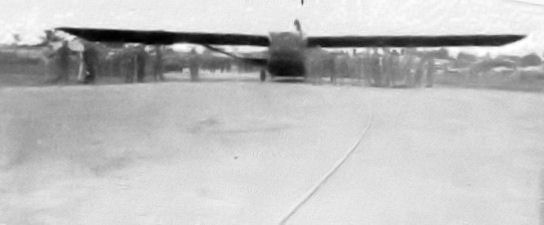
Assembled Glider ready for flight at Eagle Farm Airfield
At the time that the above photos were taken, the men of the 81st Air Depot Group had assembled 3 gliders with another 28 left to assemble. The book "There Will Always be an 81st" states:-
"These gliders have a fifteen-passenger capacity - can even carry a jeep - but for the most part are used for transporting supplies and troops."
"One plane can tow three gliders. The control personnel consists of a pilot and a co-pilot."
"A difficulty - the air currents about this part of the country are treacherous for gliders. The gliders are whipped around and consequently this causes the tow ship to bounce about."
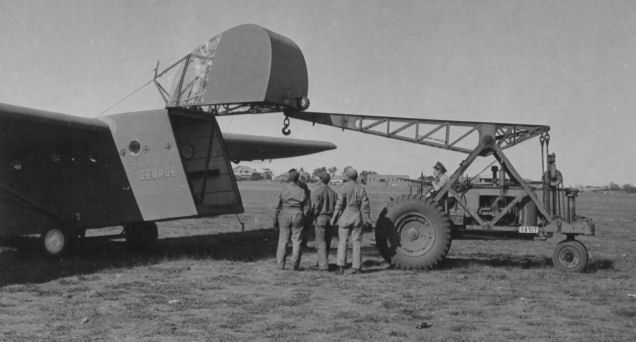
Photo:- SC GHQ-SWPA-43-5704
Nose of Cargo Glider "George"
opened prior to being loaded by the
Directorate of Air Transport with freight at Archerfield Airfield, May 1943
The book "Silent Wings" by Gerard Devlin, details the account by one of the glider pilots, Flight Officer William T Sampson, who was a member of the group that arrived in Australia. He stated that 30 gliders in crates were at Eagle Farm Airfield. He also stated that 25 of the assembled gliders were flown 400 miles to Port Moresby where they were loaded with engineering construction equipment and then flown over the Owen Stanley Mountains to Dobodura. On June 28, 1942, F/O Sampson was the first AAF glider pilot to receive the newly designed glider pilot wings having the "G" on them.
The CG-4A gliders that had been readied for the airborne attack on Nadzab were not used as the paratroop attack proved successful and the gliders were not needed. The gliders were then placed in outside storage at Dobodura and the glider pilots reassigned to other duties. Half of the CG-4A glider pilots were assigned to fly L-5 Stinson observation aircraft with artillery battalions to direct artillery fire on Japanese infantry positions. The other CG-4A pilots became co-pilots of C-47 aircraft carrying troops and supplies from Port Moresby over the Owen Stanley Range to recently captured Japanese airfields.
The 187 Glider Infantry Regiment, 188 Glider Infantry Regiment and the 511th Parachute Infantry Regiment of the 11th Airborne Division , arrived in New Guinea on May 25th and by the middle of June were encamped at Dobodura. Here they began a series of maneuvers designed to practice for the upcoming invasion of the Philippines. The practice was to include glider tows and landings but the only gliders available were the 25 Wacos which had been left outside since September 1943 when the Nadzab glider landing had been cancelled. Unfortunately, the high humidity, almost constant rain, and scavengers had resulted in these 25 gliders becoming unserviceable for use.
A new shipment of crated gliders arrived at Finschhafen by ship and were assembled there and flown to Lae. There were 25 Waco CG-4A gliders and 4 of the larger CG-13A gliders. They were assembled by the 1st Provisional Glider Group headed by Major Edward C. Milau and dispatched from the US. 26 glider pilots and 26 glider mechanics assembled them in a week and tug ships from the 54th Troop Carrier Wing then towed the gliders to Dobodura to be used in training with the 11th Airborne Division. All these gliders at Dobodura and Nadzab were later flown out to Biak when the 11th Airborne Division left.

Patch for 1st Provisional Glider Group, 54th Troop Carrier Wing
A new shipment of crated gliders, originally destined for Port Darwin, arrived at Finschhafen and Lae. There were 25 Waco CG-4A gliders sent to Lae and 5 of the larger CG-13A gliders were sent to Finschhafen. The CG-4A gliders were assembled by the 1st Provisional Glider Group which had been dispatched from the US and was made up of 26 glider pilots and 26 glider mechanics headed by Major Edward C. Milau while glider pilot Earl Simson was assigned the Engineering Officer in charge of the assembly. The gliders were needed quickly and the glider pilots and mechanics assembled them in a week. The tug ships from the 54th Troop Carrier Wing then towed the gliders the short distance from Lae to Nadzab to be used in glider training with the 11th Airborne Division beginning on 2 September 1944.
Glider training was completed by the end of September and amounted to a total of 727 glider flight hours and 1,242 glider tows performed. The glider training program was marred due to a mid air collision when two gliders collided at 200 feet and one of the glider crashed, killing nine personnel and injuring five. Two L-5 Stinson Sentinels were assigned to the 54th Troop Carrier Wing for assisting with glider training. The L-5s were temporarily assigned to the 433rd Troop Carrier Group.
Gliders and personnel were assigned to the 433rd Troop Carrier Group. Glider flight training continued for the troop carrier squadrons during the month of October. Glider operations showed 729 aircraft hours flown with 973 glider landings. Seven gliders were destroyed during October. The 433rd received 18 additional gliders and crews with 46 glider pilots and 31 glider mechanics now with the group.
The first operational use of gliders in the Southwest Pacific Area was on 17 October 1944 when four CG-4A gliders loaded with personnel and engineering equipment were towed to IFITAMIN in central New Guinea to build an emergency landing field between Hollandia and Merauke. It was decided later that retrieval of the gliders from the small emergency strip was not safe and they were left there to deteriorate.
The 54th Troop Carrier Wing and its troop carrier groups had completed their move to Biak in November 1944. Serviceable gliders that had been used at Nadzab were towed to Biak. Glider training continued as the 46th Troop Carrier Squadron undertook glider training with 122 glider flight hours and 78 glider tows for the month of November 1944.
The 4th Glider Section of the 54th Troop Carrier Wing arrived at Lae in New Guinea on 12 November 1944 and Hollandia on 14 November 1944 aboard USS Latimer. The 4th Glider Section went ashore via LCI and proceeded to the 22nd Replacement Centre. They flew to Biak via C-47s on 16 November 1944 where they were reallocated to the 65th Troop Carrier Squadron.
A total of 10 Glider Sections comprising 340 Officers and 490 Enlisted Men arrived at Biak in November 1944 with approximately 90% of authorised organisational equipment. They were then assigned to the newly activated 1st Glider Group (Provisional).
| 4th Glider Section Personnel
November 1944 Commanding Officer & Operations Officer:- Captain Maxwell P. Farnsworth Flight 1:- 2nd Lt. Errol T Stackstill Flight 2:- 2nd Lt. William S Springer Flight 3:- F.O. Richard G. White Flight 4:- 2nd Lt. Robert C. Meyer Assistant Operations Officer:- F.O. Roy
C. Reynolds T/Sgt Roland F. Brasell was allotted duty as Acting First Sergeant. Sergeant Thomas D. Matthews and Pfc Robert L. Gresham were assigned as clerks Strength of Section:- 34 Officers and 49 Enlisted Men |
In December 1944, Major Edward C. Milau (O-348365) was relieved of his duties with Headquarters 54th Troop Carrier Wing and was assigned to 1st Glider Section to take over glider operations.
In January 1945, a request was submitted to the Fifth Air Force to authorise the transfer to Far East Air Forces (FEAF) Combat Replacement and Training Centre all of the CG-4A and CG-13A gliders at Nadzab to a pool which would be used for future training needs. These gliders were no longer suitable for combat duty. The request also requited all uncrated gliders at Nadzab to be delivered to Leyte.
In January 1945, the Fifth Air Force ordered a delay in the proposed disbandment of the Glider Group. Glider pilots were distributed amongst the flying squadrons of the 54th Wing, 21st Service Group, Wing Headquarters and the 33rd Signal Company. 100 Enlisted Men of the Glider Section were also placed on Detached Service with the flying groups. The 375th Troop Carrier Group continued to make available five C-47s every day practice glider tows through to 28 January 1945. The 2nd Combat Cargo Group provided five C-46s for glider towing practice from 29 January 1945.
Crash landing of a Glider between Cape Upstart
and
Abbott Bay, Queensland on 19 August 1943
Crash of a Glider at Sarina near Mackay,
Queensland on 19 August 1943
Death of a Glider Pilot in the
Brisbane area on 14 August 1943
Forced Landing of a CG-4A Glider behind Mount
Morgan
Railway Station, Queensland on 4 September 1943
Forced landing of a USAAF Glider near Mount
Pleasant
in SE QLD on an unknown date during WWII
81st
Air Depot Group Assemble Gliders at Eagle
Farm Airfield, Brisbane, Queensland during WWII
11th Airborne Division in the
Southwest Pacific Area during WWII
58th
Troop Carrier Squadron, 375th Troop
Carrier Group flew Gliders to Dobodura
Photo of CG-4A Glider at the Townsville
Air Depot (Depot No. 2) in Townsville
REFERENCE BOOKS
Tactical Employment in the US Army of Transport Aircraft and Gliders in World War II, Ch 1-1V, Vol1, dated 19 June 1946
Allied Air Transport Operations South West
Pacific Area in WWII, Volume Four - 1944 - Supporting the Allied Advances
by Robert H. Kelly
"Silent Wings"
by Gerard Devlin
ACKNOWLEDGEMENTS
I'd like to thank Jim Moffett and Trent Telenko for their assistance with this web page.
Can anyone help me with more information?
"Australia @ War" WWII Research Products
|
© Peter Dunn 2015 |
Please
e-mail me |
This page first produced 6 November 2017
This page last updated 25 July 2021